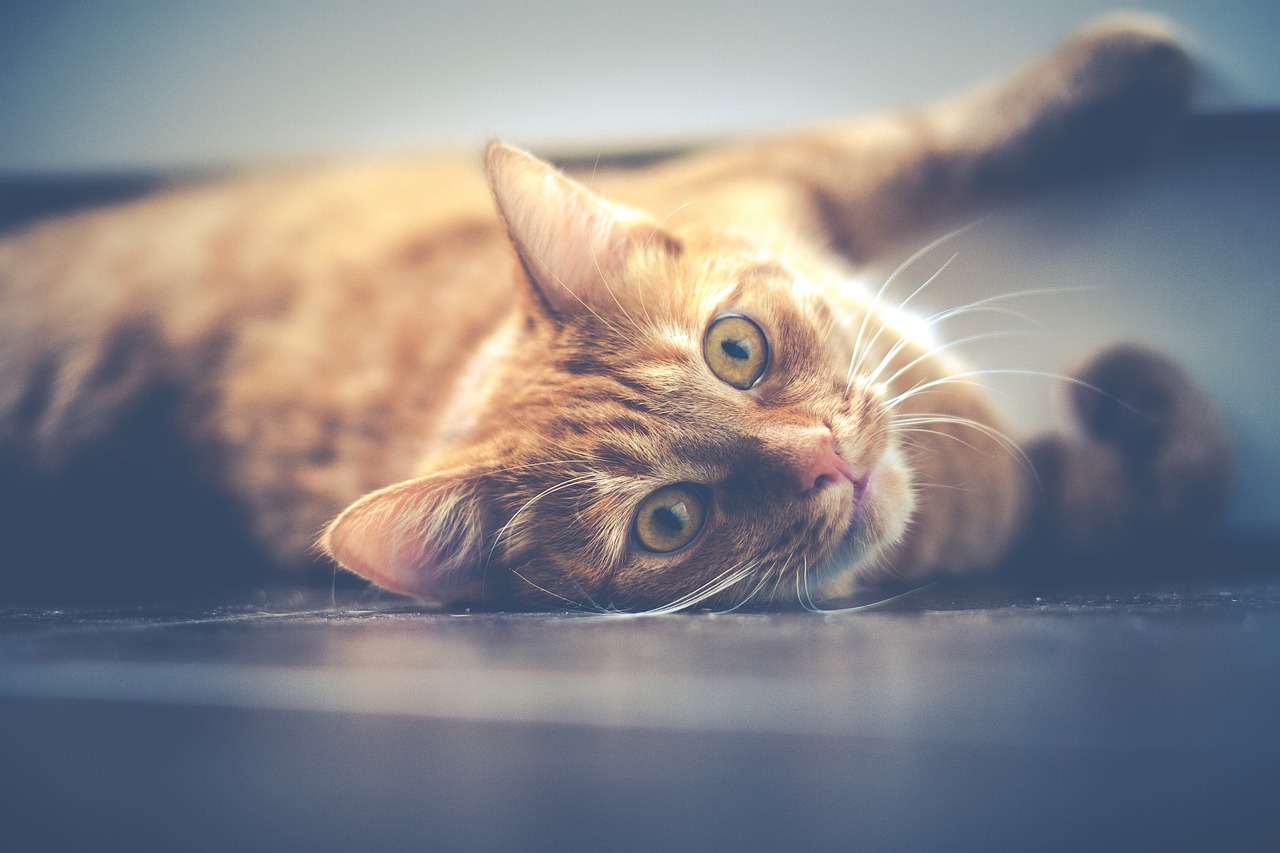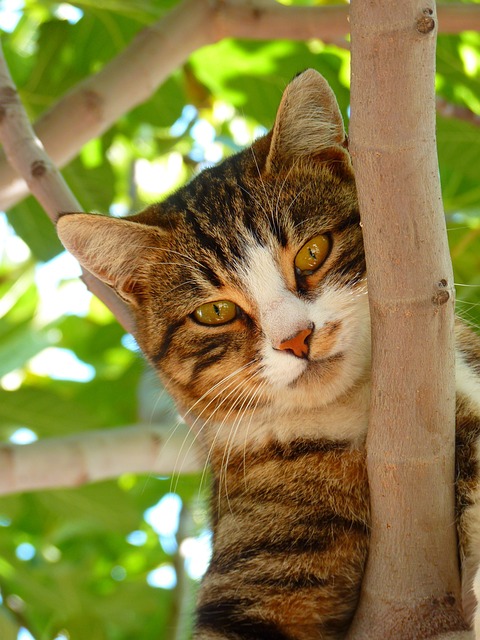Feline skin Diseases, Including Fungal Infections rank among the most common health issues that cat owners face, often causing distress not only for the pet but also for the owner. Skin diseases can range from mild irritations to severe infections that compromise a cat’s overall well-being. They may lead to persistent itching, redness, hair loss, and in some cases, secondary infections that require long-term care. Understanding the causes, recognizing the symptoms early, ensuring accurate diagnosis, following proper treatment, and adopting preventive strategies are essential steps for maintaining your cat’s skin health and ensuring a happy life for your feline companion.
Common Skin Diseases in Cats
Cats are prone to a variety of skin disorders, which can arise from infections, allergies, parasites, or even genetic factors. Identifying the exact cause is critical for effective treatment, as many skin problems share similar symptoms. Here are the most common feline skin diseases:
1. Fleas and Parasites
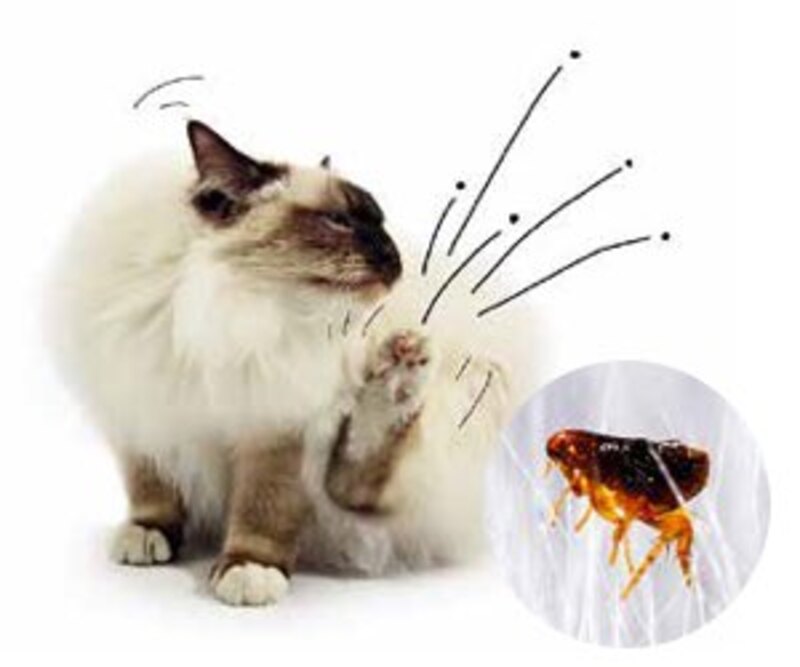
Fleas are among the most frequent causes of skin irritation in cats. Even a small flea infestation can lead to intense itching and discomfort. Flea bites inject saliva into the cat’s skin, causing an allergic reaction known as flea allergy dermatitis (FAD), which can be severe. Other parasites such as mites, ticks, and lice can also infest a cat’s skin, leading to scratching, hair loss, and inflammation. Mites, for instance, burrow into the skin or live on its surface, causing conditions like mange, which can spread quickly if left untreated.
Symptoms:
- Intense scratching or biting at the skin, especially near the neck, tail base, and belly.
- Small black or brown specks, known as flea dirt, on the fur.
- Red, inflamed skin patches that may become scabbed or infected.
- Hair loss, often in small patches.
Treatment:
Treatment requires a multi-step approach. Veterinarians typically recommend topical or oral anti-parasitic medications, which effectively kill adult fleas and prevent new infestations. Environmental management is equally important; washing bedding, vacuuming carpets, and treating furniture can eliminate eggs and larvae. Regular use of flea preventives is essential to avoid recurring infestations, particularly in multi-cat households or homes with outdoor cats.
2. Feline Skin Diseases, Including Fungal Infections
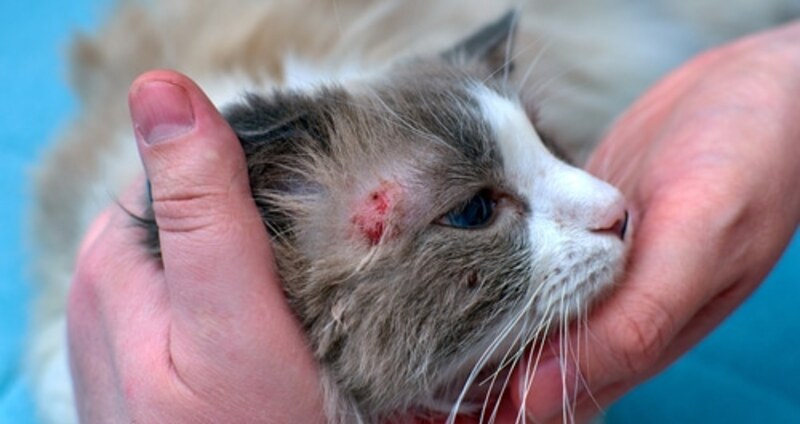
Fungal infections, particularly ringworm, are another common Feline Skin diseases . Despite its name, ringworm is not caused by a worm but by a type of fungus called dermatophytes. Ringworm is highly contagious, not only to other animals but also to humans, making early detection and treatment vital. The fungus thrives in warm, moist areas, and cats with compromised immune systems are especially vulnerable.
Symptoms:
- Circular or irregular patches of hair loss, sometimes with broken hairs.
- Scaly, crusty, or thickened skin that may be red or inflamed.
- Itchiness, although some cats show minimal scratching.
- Spread of lesions to other areas if untreated.
Treatment:
Treatment may involve a combination of topical antifungal shampoos or dips and oral antifungal medications for more severe cases. Because ringworm spores can survive in the environment for months, thorough cleaning and disinfecting of living areas, bedding, and grooming tools are crucial. Owners should also wear gloves and practice hand hygiene to prevent transmission.
3. Bacterial Infections
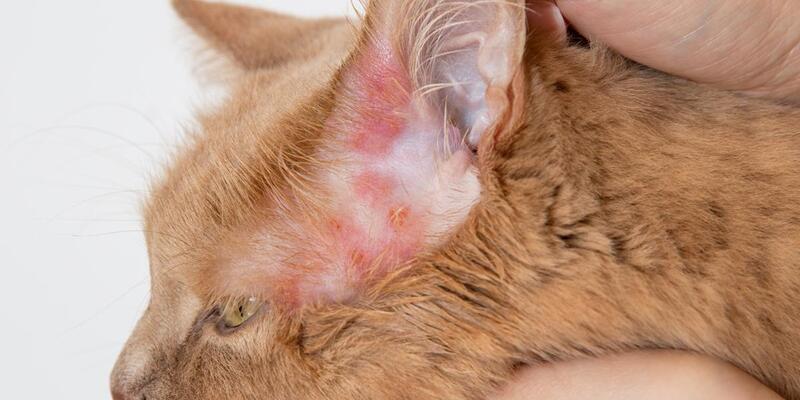
Bacterial infections often occur secondary to other skin issues, such as wounds, allergies, or parasitic infestations. One common bacterial skin infection in cats is pyoderma, which can cause pustules, swelling, and pain. In some cases, bacterial infections can develop rapidly, leading to systemic illness if not addressed promptly.
Symptoms:
- Red, swollen, or oozing areas on the skin.
- Pustules or scabs, which may have a foul odor.
- Pain or tenderness when touched.
- Sometimes fever or lethargy if infection spreads.
Treatment:
Bacterial infections require targeted treatment, usually in the form of oral or topical antibiotics prescribed by a veterinarian. In addition, cleaning the affected areas with antiseptic solutions can help reduce bacterial load. Identifying and addressing the underlying cause, such as flea infestation or allergies, is critical to prevent recurrence.
4. Allergic Dermatitis
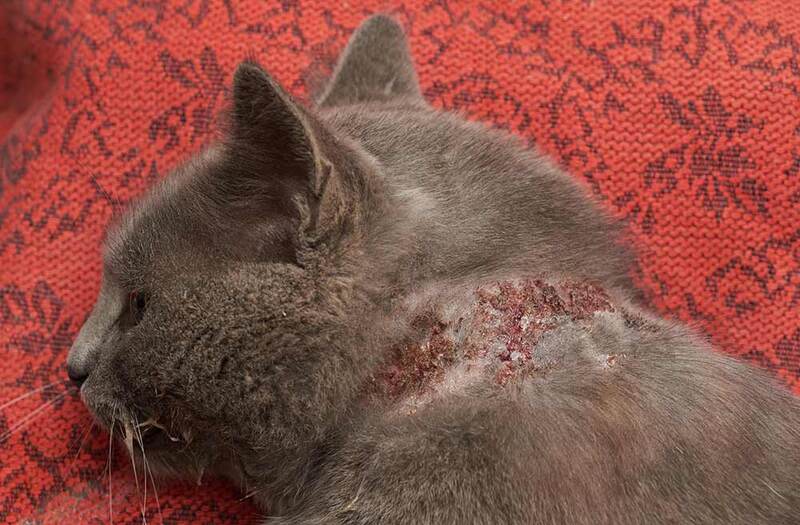
Allergies are a frequent cause of feline skin diseases and can be triggered by food, environmental factors, or even flea bites. Cats with allergic dermatitis often develop chronic itching, redness, and hair loss. Unlike humans, cats may not sneeze or show respiratory symptoms; instead, they express their discomfort through excessive grooming or scratching, leading to self-inflicted wounds.
Symptoms:
- Persistent scratching or licking of specific areas, such as the ears, paws, and belly.
- Red, inflamed skin or hot spots caused by constant grooming.
- Hair loss, sometimes in large patches.
- Behavioral changes such as irritability or withdrawal due to discomfort.
Treatment:
Treatment focuses on identifying and removing the allergen. For food allergies, veterinarians often recommend a hypoallergenic diet or elimination trials. Environmental allergies may be managed by minimizing exposure to dust, pollen, or household chemicals. Anti-inflammatory medications, including corticosteroids or antihistamines, can provide relief, while medicated shampoos soothe irritated skin.
5. Miliary Dermatitis
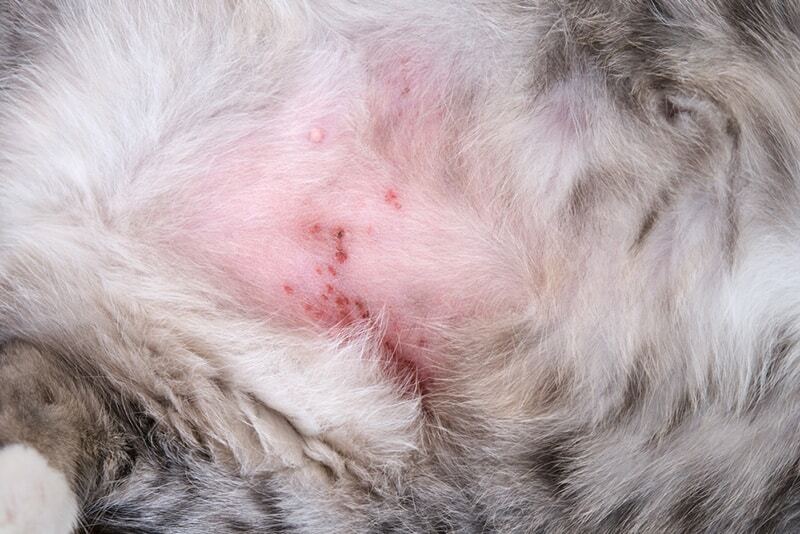
Miliary dermatitis is a common inflammatory skin condition in cats, often associated with flea bites, allergies, or infections. It is characterized by small, crusty bumps on the skin that may form itchy clusters, causing significant discomfort. Cats with miliary dermatitis may develop secondary bacterial infections due to scratching and open wounds.
Symptoms:
- Tiny, crusted papules primarily located on the back, neck, or abdomen.
- Severe itching and scratching.
- Hair loss around affected areas.
- Occasionally, secondary infection leading to pus or scabs.
Treatment:
Treatment involves addressing the underlying cause, whether fleas, food, or environmental allergies. Corticosteroids may be prescribed to reduce inflammation, while antibiotics treat any secondary bacterial infection. Consistent grooming and monitoring are essential to prevent worsening of lesions.
6. Eosinophilic Granuloma Complex
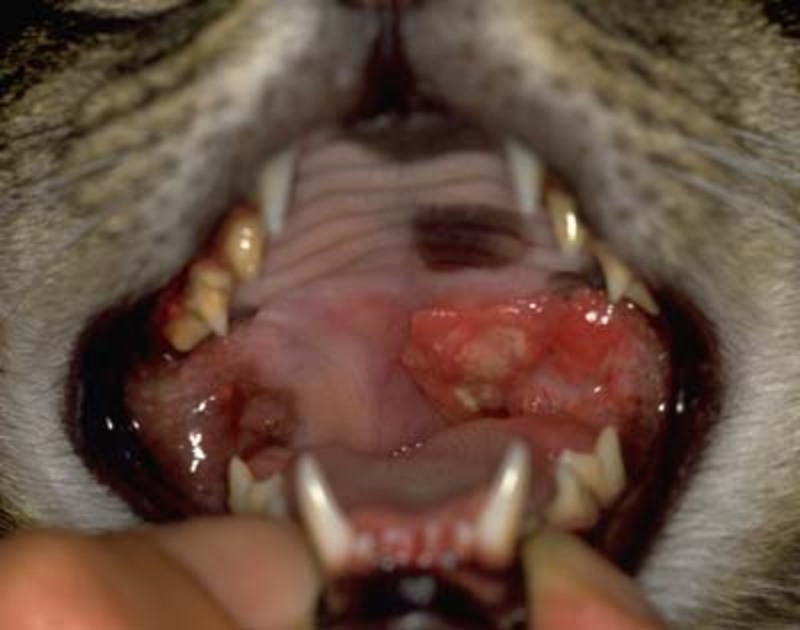
Eosinophilic granuloma complex (EGC) refers to a group of immune-mediated skin lesions commonly linked to allergic reactions in cats. These lesions can appear as ulcers, plaques, or linear granulomas and are most often seen on the lips, chin, thighs, or abdomen. The exact cause is not fully understood, but allergies, insect bites, or underlying immune dysfunction are often implicated.
Symptoms:
- Swollen, red, or ulcerated skin lesions.
- Discomfort or pain, especially when lesions are touched.
- Licking or chewing at affected areas.
- Recurrence despite treatment if the underlying cause is not addressed.
Treatment:
Treatment may include anti-inflammatory medications and corticosteroids to reduce immune response and inflammation. Identifying and managing allergies through diet, environmental changes, or medication can prevent recurrence. In severe or chronic cases, immunosuppressive therapy may be recommended under veterinary supervision.
Diagnosing Skin Diseases in Cats
Accurate diagnosis is key to effective treatment. Because many feline skin diseases share similar symptoms, veterinarians often use multiple diagnostic methods:
- Physical Examination: A careful inspection of the cat’s skin, fur, and general health helps identify visible lesions, hair loss patterns, and areas of inflammation.
- Skin Scraping: This technique involves gently scraping the surface of the skin to collect samples for microscopic examination, useful for detecting mites or other parasites.
- Fungal Culture: Culturing hair or skin samples confirms fungal infections such as ringworm.
- Allergy Testing: Blood tests or intradermal skin tests help identify environmental allergens causing dermatitis.
- Blood Tests: Comprehensive bloodwork can reveal underlying systemic conditions, such as hormonal imbalances or immune disorders, contributing to skin problems.
- Biopsy: In rare or severe cases, a small skin sample may be taken to diagnose tumors or complex immune-mediated diseases.
Treatment Options for Feline Skin Diseases
Treatment strategies vary depending on the cause but usually include a combination of approaches:
- Topical Treatments: Shampoos, creams, and ointments treat infections, reduce inflammation, and soothe itchy skin. Medicated shampoos with antifungal, antibacterial, or anti-inflammatory properties are widely used.
- Oral Medications: Antibiotics, antifungals, or anti-parasitic drugs may be necessary for systemic treatment. Anti-inflammatory drugs help manage allergies and immune-mediated reactions.
- Environmental Management: Cleaning the living environment, controlling fleas, and reducing exposure to allergens are critical steps in treatment.
- Dietary Adjustments: Hypoallergenic diets or novel protein diets help cats with food-induced allergies.
- Behavioral Support: Reducing stress through play, routine, and environmental enrichment can minimize excessive grooming and prevent self-inflicted injuries.
Preventing Skin Problems in Cats
Preventive care is vital for maintaining healthy skin. Key strategies include:
- Regular Grooming: Brushing removes loose hair, dirt, and mats that can harbor bacteria or parasites. Grooming also allows owners to notice early signs of skin problems.
- Flea and Parasite Control: Consistent use of veterinarian-recommended flea preventives protects cats from infestations that lead to itching and secondary infections.
- Balanced Nutrition: A diet rich in essential fatty acids, vitamins, and minerals supports skin health and overall immunity.
- Clean Environment: Frequent cleaning of bedding, toys, and litter boxes helps prevent fungal and bacterial infections.
- Routine Veterinary Checkups: Early detection of skin issues allows prompt treatment, preventing chronic or severe problems.
- Stress Reduction: Providing a calm environment and enriching activities reduces stress-related grooming behaviors that damage skin.
When to See a Veterinarian
Immediate veterinary attention is necessary if you notice:
- Persistent scratching or licking that does not improve
- Hair loss or bald patches developing quickly
- Red, inflamed, or oozing skin
- Foul odor or scabs
- Unexplained behavioral changes such as aggression, lethargy, or hiding
Early diagnosis and treatment prevent complications such as chronic infections, severe dermatitis, or systemic illness. A proactive approach ensures a comfortable, healthy life for your cat.
Conclusion
Skin diseases in cats are common but largely manageable with timely intervention and proper care. By understanding the causes, recognizing early symptoms, ensuring accurate diagnosis, and applying appropriate treatments, cat owners can maintain the health and well-being of their feline companions. Regular grooming, flea prevention, balanced nutrition, and routine veterinary checkups are fundamental strategies for preventing skin problems. Remember, a shiny, healthy coat reflects a healthy cat—both physically and emotionally. With attention, care, and vigilance, your cat can enjoy a life free of painful skin issues and discomfort.




